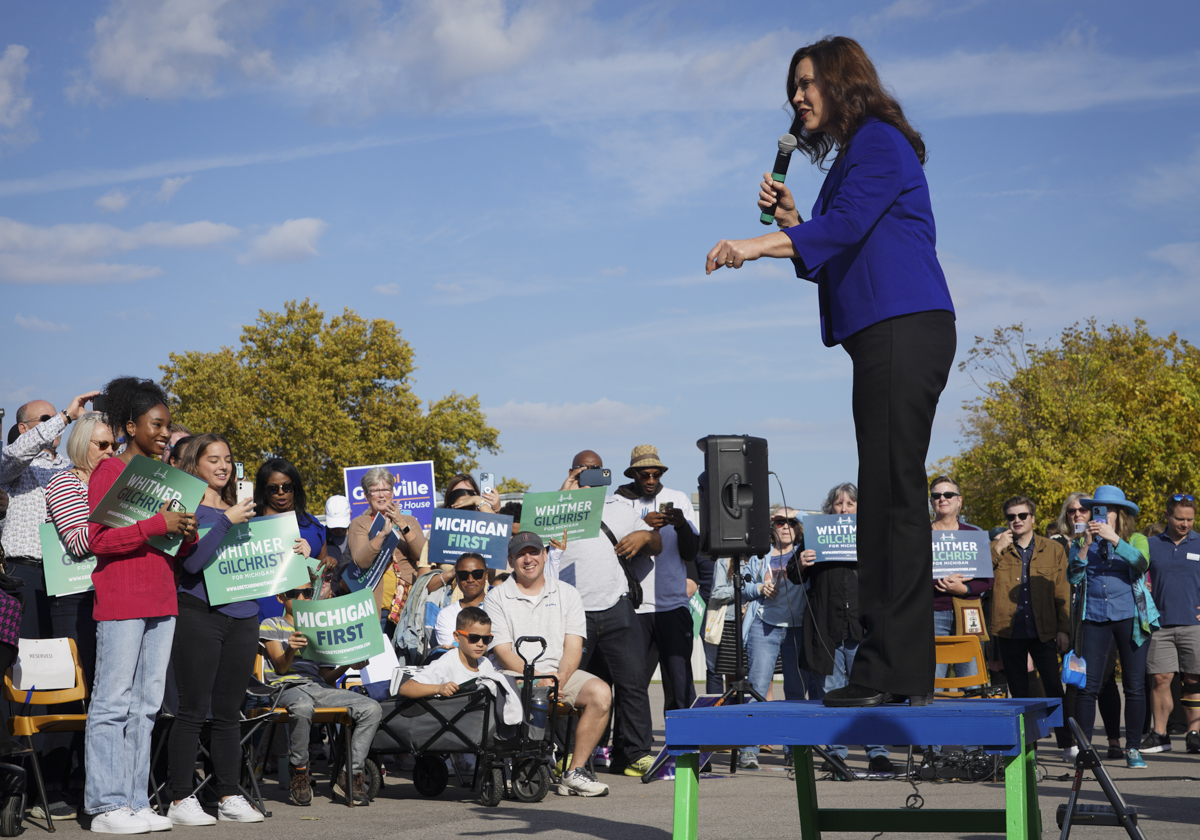How Proposal 3 and ‘Trump-era Politics’ Turned Kent County Blue
In a county expecting a particularly close governor’s race, Democratic incumbent Gretchen Whitmer beat Republican challenger Tudor Dixon by 11 percentage points. Conversations with Kent County voters suggest that the magnitude of Whitmer’s win was unexpected.
An 11-point win by Whitmer was surprising in Kent, an Urban Suburbs county that, historically, used to be reliably Republican. Although recent election data has shown a shift to the left, the number of Democratic votes is significantly higher than ever before.
Prior to Whitmer’s 2018 win, Kent County voted Republican for two decades straight in both gubernatorial elections. Whitmer more than doubled her win margin in her reelection compared to her first campaign in 2018, in which she beat Republican candidate Bill Schuette by 4 points.
Civil engineer and Kent County resident Guy Nelson said Whitmer’s large win margin may be attributed to a pushback against former president Donald Trump. He said Dixon, who publicly supported and was endorsed by Trump, would have had a closer race if she was a more “traditional Republican.”
“It reflects how Trump is turning people off now,” Nelson said. “He got people enthusiastic about voting for him and now he’s just gone too far. I definitely know people who did vote for him and now aren’t as enthusiastic about voting for him anymore or voting for any of the people who support that type of view.”
Mike Lomonaco, HealthBar sales and marketing director and former campaign director in Kent County, said the midterm elections as a whole could be viewed as a response to Trump and his impact on the political sphere.
“I believe that the results in Michigan, as well as when you zoom out nationally, speak very clearly to the notion that the general electorate is very tired and done with election deniers and just the general Trump-era of national politics,” Lomonaco said.
Grand Valley State University sophomore Cameron Taylor said he felt like a large number of students were motivated to vote by the prevalence of Republican candidate campaign signs in the area. He thought Whitmer gained some Republican voters because Dixon’s stances were so far to the right.
“Pretty much, if anyone wasn’t a full Republican, I heard them talking about Whitmer,” Taylor said.
The total number of Kent County voters was higher for the 2022 election compared to past gubernatorial elections.
Why Voter Turnout Was High
Whitmer’s win may also be attributed to the high voter turnout in Kent. The voter turnout rate of 59%, according to AcessKent, was significantly more than midterm elections usually draw. However, this was two points lower than the previous midterm in 2018, which was widely referred to as a record-breaking year for turnout. Shown by the graph above, even the number of Kent residents registered to vote has grown significantly since 2006.
Voter turnout may have remained high due to one contested issue in particular: Proposal 3, which would put the right to abortion in the state constitution. Kent passed the proposal with 54.75% of the vote, according to AccessKent. Conversations with voters suggest that the proposal was the main driver to the polls.
“I think there's no question that Proposition 3 drove significant voter turnout on both pro- and anti- sides, but certainly on the pro-side,” Lomonaco said.
Nelson and his wife, Rebekah Nelson, agreed that Proposal 3 brought a high number of voters, particularly left-leaning voters, out to vote.
“Proposal 3 had a huge influence on people coming out and not wanting to regress and continue to allow women to have rights and to make their own choices,” Rebekah Nelson said. “I feel people were fired up about it, for sure.”
Taylor said Proposal 3 was one of his main motivations for voting. Taylor’s roommate, Grand Valley State University sophomore Jenni-Lee Lundell, noted that she felt a dominating female presence at the polls, which she assumed was due to the proposal.
Going forward, the election results may be an indicator of how Kent will vote in future elections. Lomonaco said he believes this election reflects a larger shift. He said it feels like voters are tired of the “conspiracy theory-led” narrative that dominated the “Trump era,” and that this new attitude will change how people vote in the future.
“‘Owning the libs’ and/or ‘owning the conservatives,’ it’s not a strategy,” Lomonaco said. “How we govern, how we get policy through, by ‘owning’ each other, by this social media-esque communication style. It’s not going to be what moves our country or our region forward. And I think that came through on Tuesday.”
Contrary to Lomonaco, Guy Nelson said he sees this election as an outlier due to the issue of Proposal 3 and Dixon’s campaign, and not as a larger shift in people’s political views. He believes that the historical voting styles of Kent will come back to form eventually, he said.
“Republican is ingrained in Kent County … this is a Republican county. I think if they get a more traditional Republican candidate, it will go back to the way it always was,” Nelson said.
Vivian Barrett is a junior journalism major at Michigan State University and works as campus administration reporter at The State News.
Marah Deary is a senior journalism major at Michigan State University.
Emile Rizk, a Northville, Michigan native, is a journalism student at Michigan State University, hoping to work with Middle Eastern companies and allow them to have their voice and product prevalent in the Western world.
Taylor Truszkowski is a senior journalism major at Michigan State University.
